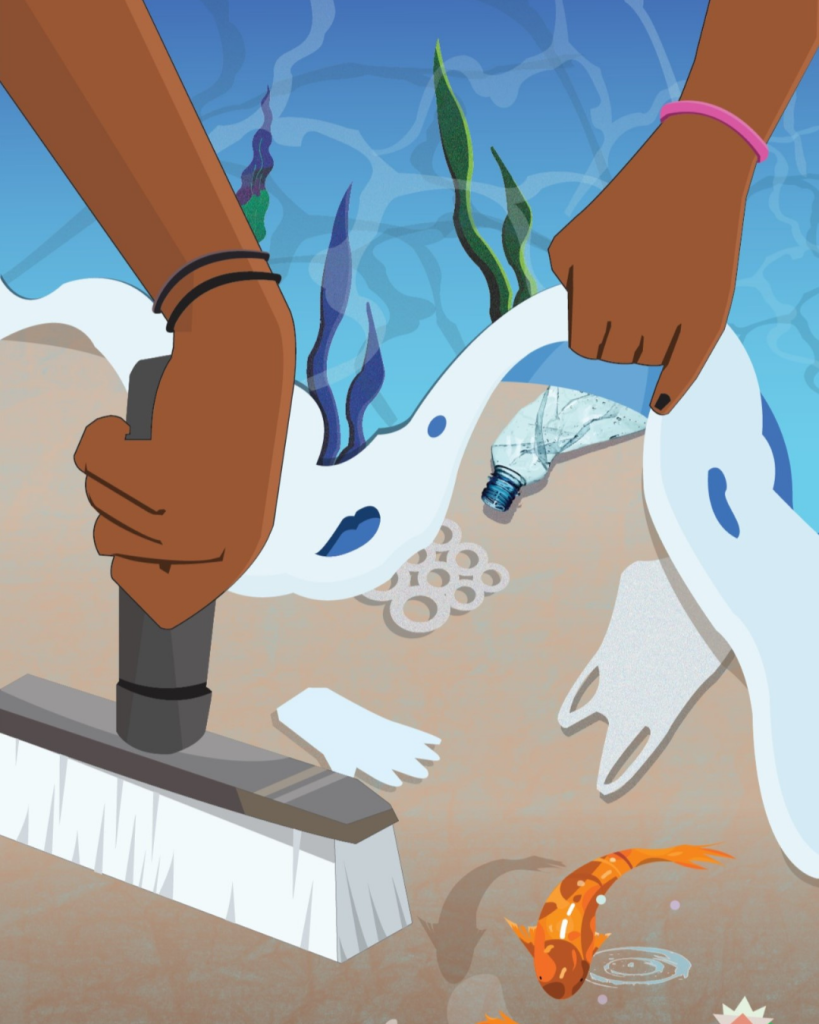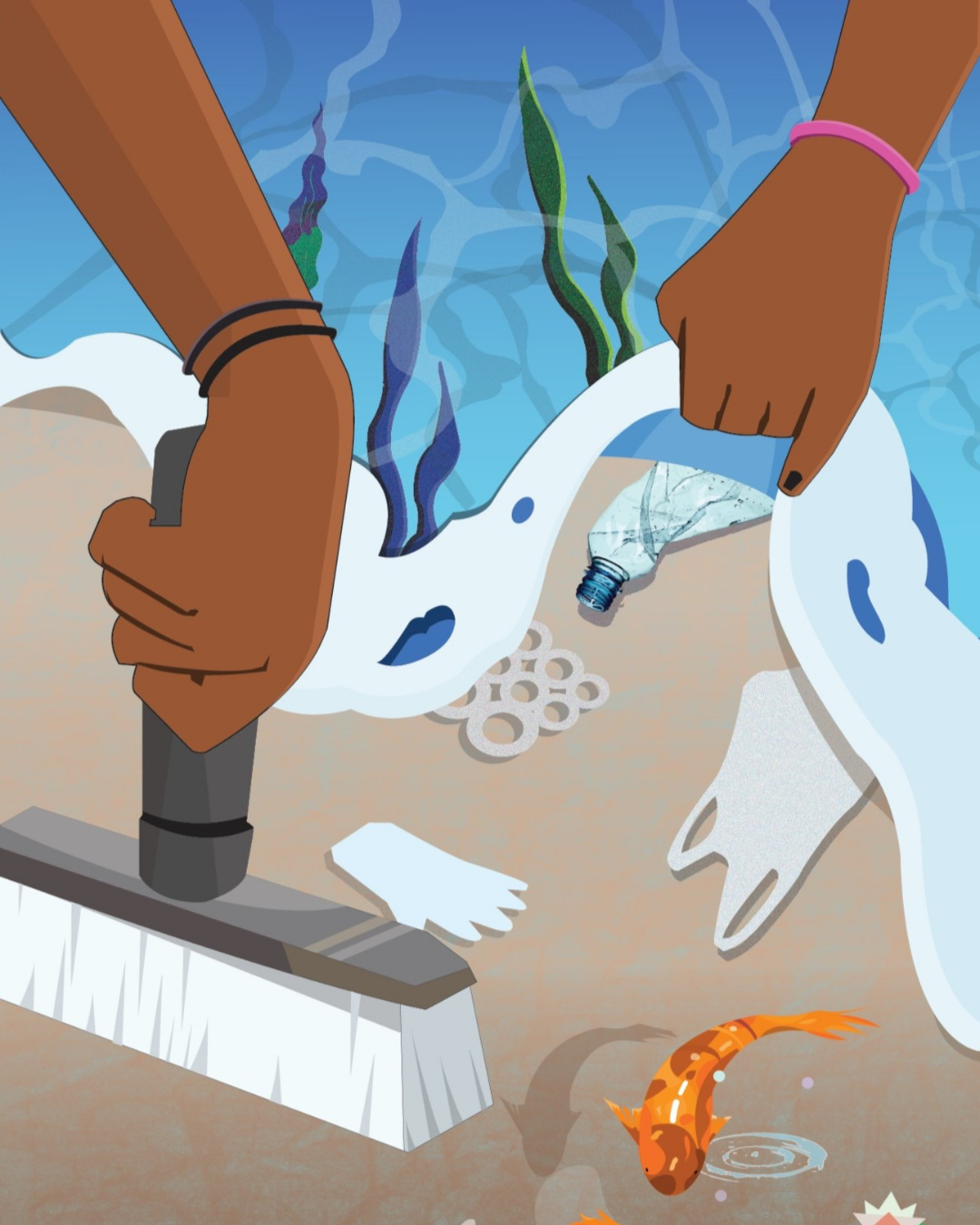Plastic pollution is a menace that continues to worsen globally. Nikola Simpson, Head of the United Nations Development Programme’s Barbados and Eastern Caribbean Blue Economy Accelerator Lab, predicted that by 2060 there will be more plastic than fish in the world’s oceans. Every year, 23 million tonnes of plastic waste leaks into aquatic ecosystems. This does not only affect the water bodies but the entire ecosystem bears the brunt of this. Plastic pollution alters habitats and natural processes, reducing ecosystems’ abilities to adapt to climate change and directly affects millions of people’s livelihoods and social well-being.

The challenge of implementing plastic waste reduction practices in Nigeria is daunting given that the country operates in a ‘sachet economy’ — where majority of products are sold in single-use plastic packaging. Although the Nigerian Federal Ministry of Environment, Lagos State government, and Oyo State government banned their use in January 2024, it has been an uphill climb for companies and individuals to adhere to this policy. Additionally, experts like Kehinde Allen Taylor believe the ban is a superficial environmental policy that might fail to achieve a meaningful impact. Challenges that confront this policy include a rise in black market sales, the high cost of eco-friendly packaging alternatives, as well as a lack of public awareness of such alternatives. The ubiquity of plastics in Nigerians’ everyday lives calls for the application of unconventional waste management methods to curtail these excesses.
Nigeria, the most populated black nation in the world, contributes greatly to plastic pollution on the continent as one of its most profitable local businesses is plastic manufacturing. In 2015, the production volume of plastic in Nigeria reached around 411,000 tonnes. In addition, Nigeria is a net importer of plastics and in 2017, the country imported 247,000 tonnes of plastic film. A 2019 report by the Voice of America stated that Nigeria generates over 2.5 million tonnes of plastic waste every year. For this reason, there is a need for all Nigerians to embrace plastic waste management methods.
The popular waste management methods in Nigeria are waste burning and recycling. Although these methods work to a certain extent, they also have drawbacks. For instance, waste burning has been proven to have poor consequences on public health. The World Health Organisation identified dioxin as one of the harmful chemical substances released from burning plastic waste. Also, recycling plastic can release harmful pollutants into the air and water. Researchers found that at least six percent of the plastic waste brought into recycling facilities is shed off when washed thereby dumping microplastics into the water. Meanwhile, other research suggests that recycling plastic may actually increase its toxicity.
At dumpsites, plastic waste and biodegradable waste are often dumped together, rendering the entire batch contaminated and unusable. Before 2018, China handled the recycling of almost half of the world’s discarded materials, because of their manufacturing boom. In 2016, the United States of America exported 16 million tonnes of waste to China. However, up to thirty percent of these mixed recyclables were ultimately contaminated by non-recyclable materials that ended up polluting China’s countryside and oceans. In a situation where waste burning is harmful, eco-friendly products are expensive, recycling is insufficient, and government policies are arduous, the issue of plastic pollution poses a dilemma to countries as they struggle to implement viable solutions. In my opinion, art, specifically eco-friendly art, is the key to solving this problem.
Plastic has been used in artistic activities since its invention. The incorporation of plastic in art production can be traced back to the beginning of the Neo-Avant-Garde art movement. It was one of the several types of waste used in creating art similar to other materials such as glass, sand, or newspapers. In this era, plastic indicated modernity, however in the 1960s, the focus shifted to the political and social dimensions of the relationship between art practices and synthetic materials. The term Junk Art was coined by Lawrence Alloway in 1961 during the exhibition “The Art of Assemblage” at the Museum of Modern Art in New York City. The participants of this art movement included artists such as Daniel Spoerri, Allan Kaprow, and Alfonso Ossorio. This contemporary approach to waste indicated a transition from regarding humankind as the central element of existence to challenging the idea that humans are distinct from the world around them and illustrating the interconnected nature of humans, animals, and technology. By the 1980s, these ecological artists fully focused on the environmental impact of waste generation. This artistic trend of the twentieth century was termed as environmental art, upcycled art, or eco aesthetics. Art was assigned the new task of generating awareness about the global and local impacts of pollution and inspiring the community to act for the Earth’s protection. Artists repurposed waste to serve a much larger visually pleasing purpose — as a catalyst for behavioural change.
In the twenty-first century, more artists globally have taken up the challenge of environmental education through artwork. Non-profit organisations such as Washed Ashore have gathered over twenty tonnes of garbage, all debris that had washed up on the Oregon coast in the United States of America, and used them to build over seventy large scale sculptures. The “Human-Free Earth” exhibition at the Ujazdowski Castle Centre for Contemporary Art in Poland in 2019 displayed an installation by Australian artist Bonita Ely. The artist used remnants of everyday objects like vacuum cleaners, childrens’ toys, plastic bags, bottles, and pipes to tell a story of the consequences of excess plastic waste on the planet. In India, Delhi-based artist Manveer Singh diverted two-hundred-and-fifty kilograms of plastic from landfills and turned it into remarkable art. In Africa, Laye Ndiaye, a Senegalese artist, is committed to the fight against plastic pollution and collects litter along the coast to transform it into works of art. In Nigeria, artists like Gbenga Adeku, Chibuike Ifedilichukwu, John Ekom, Emmanuel Adebayo, Esther Ubak, and Samuel Anyanwi are also saving the planet one craft at a time by using plastic waste to bring their art to life.
In an interview, the famed Nigerian plastic waste artist Gbenga Adeku stated, “I picked an interest in exploring several waste materials — paper tubs, waste chemicals, different containers, PEP bottles, etc. It was a bit revolutionary because this is when I discovered the importance of plastics to art, and simultaneously how detrimental it is to the environment. This is when I became an environmentalist,” he said. Gbenga’s sculptures and installations infuse messages of hope, sustainability, and the survival of the ecosystem. He creates his signature art pieces depicting colourful fishes — a direct warning to individuals that oceanic life is at risk.
Chibuike Ifedilichukwu, another Nigerian environmentalist and multidisciplinary artist learnt the art of basket weaving from his grandmother and credits an expansive school curriculum that encouraged learning vocational skills like Ikpa Nkata (an Igbo word for weaving baskets) as the inspiration behind his eco-friendly art. With the use of old tins and plastic waste, Chibuike produces colourful life-sized portraits of important figures like Barack Obama, Kamala Harris, and Davido. His artworks align with his powerful personal statement: “Where others see waste, I see unprocessed gold.”
Art, unlike other techniques of waste management, does not only repurpose plastic waste but raises awareness on plastic pollution and compels action. At the ArtCOP21 that accompanied the 21st United Nations climate summit, a research team discovered that when people encounter ecological artwork it leads to increased climate policy support, which is mostly inspired by emotional stimulation. Taking into account the immense positive impact of Eco Art, the question of how to increase the number of Eco Artists is paramount. Gbenga suggests collaborations and not just with galleries and museums but with non-governmental organisations and companies that are focused on environmental preservation. “Getting out of the circle will help us reach individuals who are not into art and wouldn’t ordinarily come to an art gallery. This will definitely pique awareness amongst Nigerians,” he says. Additionally, artists like Chibuike are open to welcoming more artists into the recycled art niche in Nigeria. “I’m intentional about posting my processes online. When younger artists tell me they want to start this, I’m quick to wave a green flag. This is what we want,” he stated.
Despite the socio-economic issues that plague the country, Nigerian artists are demonstrating the power of creativity in addressing the crucial issue of plastic pollution. Through innovative art forms, they are raising awareness, inspiring action, and offering tangible solutions to tackling this problem. These artists require tangible support from policymakers, communities, individuals, and organizations. Supporting these artists, engaging with their work, and adopting eco-conscious practices will aid in providing a cleaner and healthier environment that will hopefully win the war on plastic pollution. With these developments, the future of a plastic-free Nigeria and world, is on the horizon.



